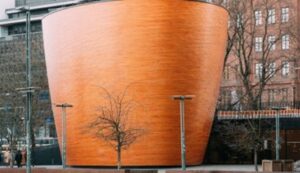
Case Study: Nanyang Technological University’s Academic Building South, Singapore
Nanyang Technological University’s Academic Building South (NTU ABS) in Singapore is one of the first timber landscrapers in the world with an enormous 42 000 m² footprint. The horizontal megastructure would be the 2nd tallest building in the world if stacked vertically and is Stora Enso’s largest delivery to a single building – living proof that replacing concrete at scale is viable. With 13 000 m³ of PEFC-certified mass timber used for the construction NTU ABS is now also Asia’s largest mass timber building too.
Nanyang Technological University’s Academic Building South (NTU ABS) joins the timber times record breakers not just for sheer size, positive health and sustainability but because it proves wood construction is also doable in rain-soaked climates.
Singapore is one of the wettest places on Earth. Located near the equator, abundant daily rainfall and high humidity pose serious challenges. During this construction, Singapore experienced the most rainfall in 40 years! It’s safe to say NTU ABS is a water ingress and moisture management test case!
If wood stays wet over extended periods, mould, cracking, or swelling can occur. Although wood is highly resilient and can even withstand being waterlogged, unlike many building materials, it’s best kept dry within a moisture content range of 11-15% during the transport, storage, construction, and in-service stages of a building to prevent such issues.
Wet weather isn’t typically an issue as contractors either erect a protective weather cover for dry storage and protection during assembly. NTU ABS is nearly the size of
Windsor Castle, so a construction tent wasn’t feasible.
But, Sylva™ by Stora Enso delivered an efficient and scalable solution. Austrian millworkers flat-packed the equivalent of three Olympic swimming pools of Sylva CLT walls, floors, roofs and stairs into 29 shipments. If each container was placed end-to-end, they’d stretch 2.8km long! Each piece was put in the correct loading sequence, with trackable labels and ready to be assembled without being exposed to moisture for a moment longer than necessary.
That may sound like a headache or the ultimate game of Tetris (depending on how you’re wired), but with Sylva it was easy. The entire delivery was completed in just 639 days between Sept 2019-June 2021 despite the pandemic and blocked Suez Canal – remember Evergreen?
How was that possible?
In the conception phase of NTU ABS project, Stora Enso worked closely with the project team. Using BIM (Building Information Modelling), a digital 3D modelling tool, everyone involved could visualize the infrastructure and break it down into components. The Stora Enso Technical Centre calculated how to machine cut 16m by 2.95m CLT with millimeter precision for maximum raw material optimisation, (a cost-saving and sustainability must for most developers).

With BIM (Building Information Modelling), a digital 3D modelling tool, everyone involved could visualize the overall building infrastructure and break it down into individual components.
Prefab construction also known as Design for Manufacture and Assembly (DfMA) lowered the construction time. From this ☝🏽 to this 👇🏽 in a third of the time had it been framed in concrete and steel.

Photo: Steeltech Industries PTE Ltd
Before shipping, Stora Enso protected Sylva elements by adding:
- – Axil 3000p+ BS to protect against insects and termites.
- – End Grain Varnish to the narrow sides for protection from water ingress, stains, swelling and shrinking.
- – All exterior vertical fins (the Sylva CLT columns you see on the exterior area) were double-side clad in larch for a beautiful visual surface and pre-coated for weather protection.
- – Sylva CLT Floors were pre-fitted with metal inserts (RAMPA®) to facilitate easy crane lifting. Sylva CLT Walls were fitted with steel plates and screws too so the crane operators could quickly and safely grip onto the installed metal anchors and slot them into position, again reducing time exposure to moisture. The lifting devices had the additional benefit of reducing accidents for contractors working at height because precise geometry in a factory-controlled setting optimally placed the devices for balancing.

With Sylva, work site injuries are virtually eliminated. Heavy equipment for cutting are performed at ground level and coatings applied in well-lit, dry and well-ventilated conditions in Stora Enso’s mills. Given falls from height are still the main cause of fatal accidents and injuries within the workplace; safety is one of the key reasons developers are switching to Sylva. Photo: Steeltech Industries PTE Ltd
Building in the rain
A body of knowledge about building timber skyscrapers now exists but the science of building horizontally is still developing. NTU ABS informs us firsthand how design and construction decisions can improve moisture management at scale.
NTU ABS was built in nine sections, split over two segments (Levels 1-3 and Level 4-Roof /15 installation sections) to reduce moisture exposure of the 8 000 m² c floor plates.

Render: Nanyang Technological University
Within only a few short months, it was apparent that the exposed internal edges of each zone were vulnerable to water ingress.
Contractors started each day, sweeping off pools of water from the wood and would repeat after the afternoon showers. Industrial-sized vacuum cleaners were also used too. In total, they removed 3 300 mm of rain.
Project plans were adapted quickly. Levels 4,5 and 6 were built up in one go, preventing exposure to moisture and enabling swift waterproofing of the 50+ balconies, terraces, bridges and skylights.
The overall result is a state-of-the-art learning environment with exposed solid structural sustainable wood. The design look and feel supports the university’s highly interactive learning model, with 25 smart classrooms for technological advancement and interactive collaboration.—–

Steeltech Industries PTE Ltd
Special thanks to Andreas Scholler, the Stora Enso project manager and David Kingham of Steeltech Industries PTE Ltd who provided the interview for this story.






